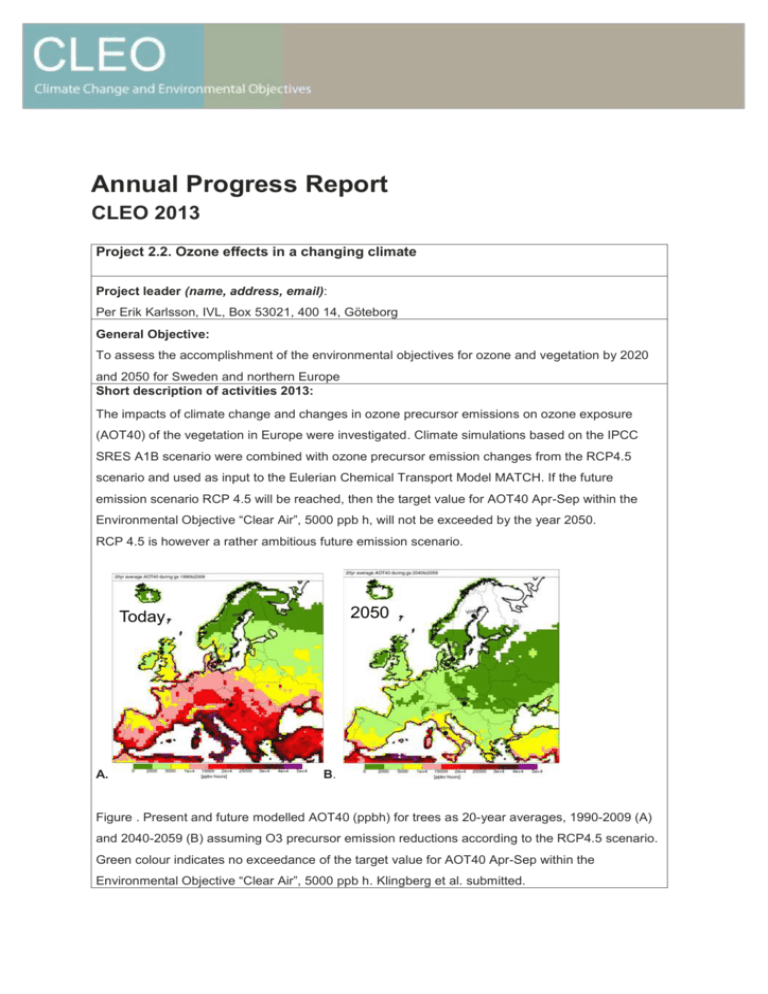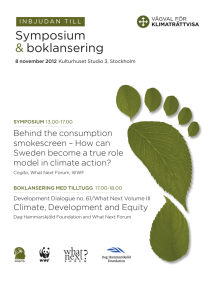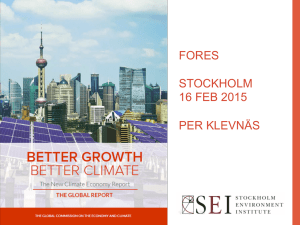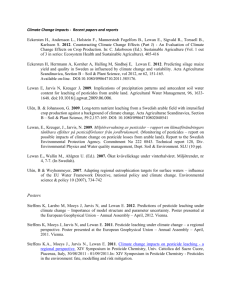Annual Progress Report CLEO 2013 - CLEO
advertisement

Annual Progress Report CLEO 2013 Project 2.2. Ozone effects in a changing climate Project leader (name, address, email): Per Erik Karlsson, IVL, Box 53021, 400 14, Göteborg General Objective: To assess the accomplishment of the environmental objectives for ozone and vegetation by 2020 and 2050 for Sweden and northern Europe Short description of activities 2013: The impacts of climate change and changes in ozone precursor emissions on ozone exposure (AOT40) of the vegetation in Europe were investigated. Climate simulations based on the IPCC SRES A1B scenario were combined with ozone precursor emission changes from the RCP4.5 scenario and used as input to the Eulerian Chemical Transport Model MATCH. If the future emission scenario RCP 4.5 will be reached, then the target value for AOT40 Apr-Sep within the Environmental Objective “Clear Air”, 5000 ppb h, will not be exceeded by the year 2050. RCP 4.5 is however a rather ambitious future emission scenario. 2050 Today A. B. Figure . Present and future modelled AOT40 (ppbh) for trees as 20-year averages, 1990-2009 (A) and 2040-2059 (B) assuming O3 precursor emission reductions according to the RCP4.5 scenario. Green colour indicates no exceedance of the target value for AOT40 Apr-Sep within the Environmental Objective “Clear Air”, 5000 ppb h. Klingberg et al. submitted. The potential influence from meteorological variables that affect plant stomatal conductance, and thus ozone uptake, under climate change was also investigated. Dryer air and soil over large parts of Europe will promote stomatal closure which leads to less ozone uptake. In colder parts of Europe, though, higher temperatures are likely to lead to larger stomatal ozone uptake by vegetation. Deliverables 2013: D2.2.1 Scientific publication: Declining risk of ozone impact on vegetation in Europe 1990-2050 due to reduced precursor emissions. Month 24. Submitted to Biogeosciences, december 2013. Additional staff involved in project: Prof Håkan Pleijel and Ph D Jenny Klingberg, University of Gothenburg. Co-operation outside CLEO: The convention on Long-Range Transboundary Air Pollution, ICP Vegetation. EU-project ECLAIR, Effects of Climate Change on Air Pollution Impacts and Response Strategies for European Ecosystems. Reports and publications: Pleijel, H. Jenny Klingberg, Gunilla Pihl Karlsson, Magnuz Engardt, Per Erik Karlsson. 2013. Surface ozone in the marine environment - horizontal ozone concentration gradients in coastal areas. Water, Air & Soil Pollution 224, 1603. Klingberg, J. M. Engardt, P. E. Karlsson, J. Langner, and H. Pleijel. Declining risk of ozone impacts on vegetation in Europe 1990–2050 due to reduced precursor emissions in a changed climate. Submitted to Biogeosciences, december 2013. http://www.biogeosciencesdiscuss.net/11/625/2014/bgd-11-625-2014.html Oral presentations: Karlsson, P.E. 2013. Effekter av marknära ozon på skog – hur bör det beaktas vid val av trädslag? Invited oral presentation. A workshop: Skogsbruk i ett förändrat klimat – Hur påverkas mångfald och miljö? Kungl. Skogs- och Lantbruksakademien (The Royal Swedish Academy of Agriculture and Forestry), Stockholm. 16 oktober 2013. Karlsson, P.E. et al. 2013. S-POD - a simplified ozone index to be used to assess the risk for negative ozone impacts on vegetation at the national level. Oral presentation at the IVP Vegetation 26th Task Force Meeting, 28st January – 30th January, 2013 Tylösand, Sweden. Pleijel, H. et al. – Ozone risk assessment for the 21st century based on ozone and climate change scenarios. Oral presentation at the IVP Vegetation 26th Task Force Meeting, 28st January – 30th January, 2013 Tylösand, Sweden. Karlsson, P.E. et al. 2013. Underlag för en fördjupad utvärdering av miljömålet Frisk Luft Marknära ozon. Föredrag på Naturvårdsverket, december 2013.


